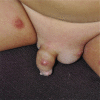Penile warts: an update on their evaluation and management
- PMID: 30622585
- PMCID: PMC6302884
- DOI: 10.7573/dic.212563
Penile warts: an update on their evaluation and management
Abstract
Background: Penile warts are the most common sexually transmitted disease in males. Clinicians should be familiar with the proper evaluation and management of this common condition.
Objective: To provide an update on the current understanding, evaluation, and management of penile warts.
Methods: A PubMed search was completed in Clinical Queries using the key terms 'penile warts' and 'genital warts'. The search strategy included meta-analyses, randomized controlled trials, clinical trials, observational studies, and reviews.
Results: Penile warts are caused by human papillomavirus (HPV), notably HPV-6 and HPV-11. Penile warts typically present as asymptomatic papules or plaques. Lesions may be filiform, exophytic, papillomatous, verrucous, hyperkeratotic, cerebriform, fungating, or cauliflower-like. Approximately one-third of penile warts regress without treatment and the average duration prior to resolution is approximately 9 months. Active treatment is preferable to watchful observation to speed up clearance of the lesions and to assuage fears of transmission and autoinoculation. Patient-administered therapies include podofilox (0.5%) solution or gel, imiquimod 3.75 or 5% cream, and sinecatechins (polypheron E) 15% ointment. Clinician-administered therapies include podophyllin, cryotherapy, bichloroacetic or trichloroacetic acid, oral cimetidine, surgical excision, electrocautery, and carbon dioxide laser therapy. Patients who do not respond to first-line treatments may respond to other therapies or a combination of treatment modalities. Second-line therapies include topical/intralesional/intravenous cidofovir, topical 5-fluorouracil, and topical ingenol mebutate.
Conclusion: No single treatment has been shown to be consistently superior to other treatment modalities. The choice of the treatment method should depend on the physician's comfort level with the various treatment options, the patient's preference and tolerability of treatment, and the number and severity of lesions. The comparative efficacy, ease of administration, adverse effects, cost, and availability of the treatment modality should also be taken into consideration.
Keywords: bichloroacetic/trichloroacetic acid; cimetidine; cryotherapy; electrocautery; human papillomavirus; imiquimod; laser; podofilox; podophyllin; sinecatechins; surgery.
Conflict of interest statement
Disclosure and potential conflicts of interest: The authors declare that there is no conflict of interest in preparing this article. The International Committee of Medical Journal Editors (ICMJE) Potential Conflicts of Interests form for the authors are available for download at http://www.drugsincontext.com/wp-content/uploads/2018/11/dic.212563-COI.pdf
Figures















Similar articles
-
Human papillomavirus: burden of illness and treatment cost considerations.Am J Clin Dermatol. 2005;6(6):365-81. doi: 10.2165/00128071-200506060-00004. Am J Clin Dermatol. 2005. PMID: 16343025 Review.
-
Management of external genital warts.Am Fam Physician. 2014 Sep 1;90(5):312-8. Am Fam Physician. 2014. PMID: 25251091
-
An evidence-based review of medical and surgical treatments of genital warts.Dermatol Online J. 2006 Mar 30;12(3):5. Dermatol Online J. 2006. PMID: 16638419 Review.
-
Human papillomavirus infection and genital warts: update on epidemiology and treatment.Clin Infect Dis. 1995 Apr;20 Suppl 1:S91-7. doi: 10.1093/clinids/20.supplement_1.s91. Clin Infect Dis. 1995. PMID: 7540876 Review.
-
Imiquimod versus podophyllotoxin, with and without human papillomavirus vaccine, for anogenital warts: the HIPvac factorial RCT.Health Technol Assess. 2020 Sep;24(47):1-86. doi: 10.3310/hta24470. Health Technol Assess. 2020. PMID: 32975189 Free PMC article. Clinical Trial.
Cited by
-
Computer-assisted sperm analysis of the epididymal spermatozoa in dromedary camels suffering from penile and preputial pathological problems.Front Vet Sci. 2025 Mar 14;12:1537708. doi: 10.3389/fvets.2025.1537708. eCollection 2025. Front Vet Sci. 2025. PMID: 40160704 Free PMC article.
-
The Effectiveness of Chemical Cautery and Electrosurgery on Anogenital Wart: Systematic Review.Clin Cosmet Investig Dermatol. 2023 Oct 5;16:2773-2780. doi: 10.2147/CCID.S426851. eCollection 2023. Clin Cosmet Investig Dermatol. 2023. PMID: 37818198 Free PMC article. Review.
-
Efficacy and Safety of Clinacanthus nutans Lindau Cream vs. Podophyllin for the Treatment of Adults with Condyloma Acuminata.Evid Based Complement Alternat Med. 2022 Jun 23;2022:1577716. doi: 10.1155/2022/1577716. eCollection 2022. Evid Based Complement Alternat Med. 2022. PMID: 35783521 Free PMC article.
-
Soluble Factors and Receptors Involved in Skin Innate Immunity-What Do We Know So Far?Biomedicines. 2021 Nov 29;9(12):1795. doi: 10.3390/biomedicines9121795. Biomedicines. 2021. PMID: 34944611 Free PMC article. Review.
-
Correlation of the ALA-PDT Treatment Efficacy and the HPV Genotype Profile of Genital Warts after Cryotherapy Failure and Podophyllotoxin Therapy in Male Patients.Life (Basel). 2021 Feb 14;11(2):146. doi: 10.3390/life11020146. Life (Basel). 2021. PMID: 33672889 Free PMC article.
References
-
- Leung AK, Barankin B. Genital warts. Consultant360.com. [Accessed September 1, 2018]. http://www.consultant360.com/articles/genital-warts.
-
- Scheinfeld N. Condylomata acuminata (anogenital warts) in adults: epidemiology, pathogenesis, clinical features, and diagnosis. In: Post TW, editor. UpToDate. Waltham, MA: [Accessed September 1, 2018].
Publication types
LinkOut - more resources
Full Text Sources

